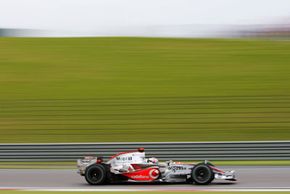Formula One Race
Sunday is race day in the world of Formula One, and it kicks off with each team plotting its strategy, trying to gain some advantage while adhering to regulations. Shortly after the rules reintroduced fueling stops, teams realized that they could carry less fuel and run faster, knowing that they could refuel during pit stops. A 2007 rule stating that all teams must use tires from a single supplier is another change that has had an enormous impact on race strategy.
Most of this planning and tuning comes down to the most critical part of a Formula One race -- the start. On many circuits, where overtaking is nearly impossible, the race start all but determines the winner of the race. The start procedure looks something like this:
Advertisement
- Thirty minutes before the race start, cars can be driven from the pit lane to their grid positions. If a car doesn't make it out of the pit lane in that half-hour window, it must start the race from there and can't enter the track until the field has completed its first racing lap.
- Once the cars are in their grid positions, mechanics make final preparations and adjustments.
- Five minutes before the race, all personnel (except the drivers) leave the grid.
- A green light signals the beginning of the formation lap, a single loop around the track. During this lap, drivers are not allowed to overtake unless it is to regain a grid position.
- At the end of the formation lap, the cars once again take up their positions on the grid. The safety and medical cars also take positions further back.
- A race official walks onto the track, behind the grid, and uses a flag to signal the race controller that the field is in place and everything is ready.
- The race controller initiates the starting light procedure. Green lights are no longer used to indicate the race start. Instead, a random sequence of red lights flashes until a final red light comes on and goes out.
- When the final red light goes out, the race begins.
The sprint to the first corner is all-important as drivers jockey for position. Depending on the quality of his start, a driver will take either an offensive or a defensive strategy. A driver on the offensive is trying to gain position, and a defensive driver is trying to protect his position. The sporting regulations specify what a defending driver is allowed to do to prevent another driver from overtaking him. If a driver is defending his position, he can't weave back and forth. He is allowed a single blocking move and no more.
As you might expect, close racing, with four or five cars abreast, is common at the beginning of the race. But after the first corner, the field begins to separate and the focus shifts from general chaos to isolated battles between drivers. Overtaking after the race start is quite difficult, although it can happen.
On the next page we'll look at three factors that affect a Formula One race after the critical start.
